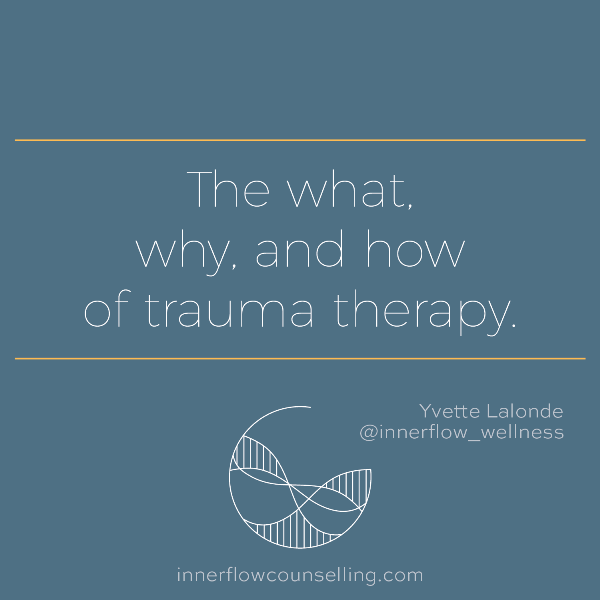
This is for you if you want to enter therapy for your past traumas but feel unsure about the process.
Three stages of trauma care
Many of my clients sigh with relief when I explain that we won’t be jumping into talking about and processing their traumas immediately. Here’s why.
One of the best working definitions of traumatic stress is anything that you experience as being deeply distressing, any experience where your nervous system is unable to find a resolution, or you don’t yet have the resources to handle the stress. In other words, any experience that is too much, too soon, or too fast.
When you enter into therapy, especially with a new therapist, the priority has to be stabilizing and building a foundation from which to start healing. If therapy moves too quickly into exploring and processing trauma, it can be more harmful than beneficial.
In the 1800s, Pierre Janet and, more recently, Judith Herman (1992) specified the three stages of trauma therapy. What follows is an adaptation of their influential work and my inclination towards a neurobiological perspective. I explain this in terms of building a house. Before building up – framework, walls, and fixtures – you need to ensure that you have a solid foundation. This is a bottom-up approach; from a psychotherapy perspective, this means we work from the body up to the mind. Simultaneously, we employ top-down methods, working with how thoughts and beliefs about yourself impact your well-being. It is an integrative and organic process meeting you where you are at.
I believe the foundation of the therapeutic process should be understanding how your unique nervous system (brain included) responds to trauma. Throughout the process, you learn tools and techniques to resource your nervous system so that you are, more often than not, engaging in your life from an adaptable and appropriate boundaried place.
This is not a linear, step-by-step process; it’s normal to shift back and forth through the stages.
Stage 1: Stabilization, security, & resourcing
- Moving from feeling unresourced to feeling resourced;
- Feeling more secure in who you are;
- Establishing stability in your environments, relationships, and sense of self;
- Reclaiming your right to take up space;
- Co-creating a roadmap and goals of therapy that are manageable, realistic, and achievable;
- Understanding the adaptive strategies* used to manage symptoms;
- Implementing functional tools and techniques to aid in nervous system regulation and symptom reduction.
This phase of therapy is deeply rooted in self-exploration, self-compassion, and education about your body systems and mental processes while taking into account social influences. It is a creative process where we learn to understand your unique brain and nervous systems and how to regulate them together through present-moment awareness, self-soothing techniques, and mindful movement.
This may sound technical, but it can be a deeply spiritual experience. In essence, you are developing a relationship with your nervous system and re-establishing your innate strengths and desires. This can sometimes lead to exploring your worldview and understanding your sacredness.
*Adaptive strategies are intelligent
ways in which you’ve automatically learned to adapt to your environment in
order to survive and thrive. As you mature and engage in more complex
relationships, these strategies begin to no longer serve you the way they use
to. These strategies are linked to physiological responses as well. Our task is
to implement more sustainable and supportive strategies that can be easily
integrated into your daily life. Adopting these strategies will naturally allow
you to shift away from harmful and unsustainable ones.
Stage 2: Processing trauma memories
- Applying nervous system regulation to working with traumatic memories* and experiences;
- Uncoupling the past from the present;
- Remembering and mourning how the past has impacted you;
- Digesting traumatic memories using a holistic approach that includes working with the body, mind, and spirit;
- Exploring boundaries;
- Expanding your ability to stay in the present moment.
In this stage, the stabilization skills developed in stage 1 come into play to promote processing while in your window of capacity (WOC). Your window of capacity is a state in which you are able to tolerate your memories, emotions, and thoughts and adapt to external stress. Nervous system resourcing techniques bring you back into your WOC, which helps build resilience and rewires your brain and nervous system to respond to stress in more sustainable ways.
*Sometimes traumatic memories become less invasive, and the need to address them lessens as you progress through stage 1.
Stage 3: Integration & reconnection
- Integrating trauma*;
- Reconnecting with others;
- Establishing healthy attachment relations;
- Realizing goals;
- Freeing your body and mind from the trauma symptoms.
In this stage of therapy, you are redefining yourself and how you relate to your world. You are actively participating in meaningful relationships, achieving personal and professional goals that are founded in post-traumatic growth, and successfully handling life’s inevitable stress.
*Integration is a part of every stage. I like to ensure that you leave sessions with realistic and achievable tools that support you in your life. In this stage, integrating your trauma refers to it no longer being a daily focus; rather, it becomes integrated into your life story.
Expected outcomes of therapy:
- Decreased symptoms;
- Increased capacity to self-regulate;
- Greater ability to feel feelings and sense sensations;
- Improved quality of life;
- Achievement of goals;
- Adoption of healthy boundaries;
- Deep connection to who you are and what you want;
- Enlarged ability to handle and navigate life stress.
